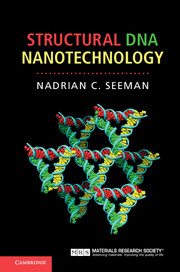Book contents
- Frontmatter
- Contents
- Preface
- 1 The origin of structural DNA nanotechnology
- 2 The design of DNA sequences for branched systems
- 3 Motif design based on reciprocal exchange
- 4 Single-stranded DNA topology and motif design
- 5 Experimental techniques
- 6 A short historical interlude: the search for robust DNA motifs
- 7 Combining DNA motifs into larger multi-component constructs
- 8 DNA nanomechanical devices
- 9 DNA origami and DNA bricks
- 10 Combining structure and motion
- 11 Self-replicating systems
- 12 Computing with DNA
- 13 Not just plain vanilla DNA nanotechnology: other pairings, other backbones
- 14 DNA nanotechnology organizing other materials
- Afterword
- Index
- References
7 - Combining DNA motifs into larger multi-component constructs
Published online by Cambridge University Press: 05 December 2015
- Frontmatter
- Contents
- Preface
- 1 The origin of structural DNA nanotechnology
- 2 The design of DNA sequences for branched systems
- 3 Motif design based on reciprocal exchange
- 4 Single-stranded DNA topology and motif design
- 5 Experimental techniques
- 6 A short historical interlude: the search for robust DNA motifs
- 7 Combining DNA motifs into larger multi-component constructs
- 8 DNA nanomechanical devices
- 9 DNA origami and DNA bricks
- 10 Combining structure and motion
- 11 Self-replicating systems
- 12 Computing with DNA
- 13 Not just plain vanilla DNA nanotechnology: other pairings, other backbones
- 14 DNA nanotechnology organizing other materials
- Afterword
- Index
- References
Summary
With the preamble of the previous chapters, we are now ready to talk about making things from DNA that are larger than individual units like the knots or catenanes or polyhedra discussed in Chapters 3 and 4. The initial goal of structural DNA nanotechnology was to self-assemble crystals, usually thought of as repeating units in three dimensions. However, the notion of periodicity is not limited to 3D; it can also apply to 2D and 1D. In fact one of the most influential ideas of the early twentieth century was Schrödinger's discussion of Delbrück's suggestion that genetic material, thought correctly at the time to be one-dimensional, was an aperiodic crystal. As we all know, that's a pretty good description of the naturally occurring DNA double helix, remarkably good for the early 1940s. In this chapter, we'll talk about one-dimensional, two-dimensional, and three-dimensional arrangements of DNA motifs. It's a little hard to separate the different types of crystals, so we will discuss them when particular points relevant to those dimensions arise, rather than separating topics by dimensionality. For example, you might think of tubular structures as one-dimensional or two-dimensional, depending on whether you are thinking about their tubular axes or about the surface arrangement of their components.
As you might imagine from all the discussion in Chapter 4, topology comes to play a major role when we concatenate DNA motifs. The basic quantum of DNA topology is the half-turn of double helical DNA; we emphasized this point when we discussed converting knot structures to single-stranded DNA constructs. Sometimes we call the half-turn a “unit tangle.” Figure 7-1 is a slightly larger version of Figure 1-8, which showed four 4-arm junctions being assembled into a quadrilateral, with lots of sticky ends left over to make something bigger. Besides the number of junctions, the difference in Figure 7-1 is that the twisting of the DNA duplex is included in the picture. Figure 7-1a shows what the structure looks like when there is an even number of double helical half-turns (in this case four) between vertices. The resulting structure is akin to chain mail, with a red circle linked twice (because there are two turns between vertices) to each of four blue strands that flank it; likewise, the blue circles are linked twice to each of the four red strands that flank them.
- Type
- Chapter
- Information
- Structural DNA Nanotechnology , pp. 97 - 129Publisher: Cambridge University PressPrint publication year: 2016



